Kathleen McKeown
Columbia University
PoSh: Using Scene Graphs To Guide LLMs-as-a-Judge For Detailed Image Descriptions
Oct 21, 2025Abstract:While vision-language models (VLMs) have advanced into detailed image description, evaluation remains a challenge. Standard metrics (e.g. CIDEr, SPICE) were designed for short texts and tuned to recognize errors that are now uncommon, such as object misidentification. In contrast, long texts require sensitivity to attribute and relation attachments and scores that localize errors to particular text spans. In this work, we introduce PoSh, a metric for detailed image description that uses scene graphs as structured rubrics to guide LLMs-as-a-Judge, producing aggregate scores grounded in fine-grained errors (e.g. mistakes in compositional understanding). PoSh is replicable, interpretable and a better proxy for human raters than existing metrics (including GPT4o-as-a-Judge). To validate PoSh, we introduce a challenging new dataset, DOCENT. This novel benchmark contains artwork, paired with expert-written references, and model-generated descriptions, augmented with granular and coarse judgments of their quality from art history students. Thus, DOCENT enables evaluating both detailed image description metrics and detailed image description itself in a challenging new domain. We show that PoSh achieves stronger correlations (+0.05 Spearman $\rho$) with the human judgments in DOCENT than the best open-weight alternatives, is robust to image type (using CapArena, an existing dataset of web imagery) and is a capable reward function, outperforming standard supervised fine-tuning. Then, using PoSh, we characterize the performance of open and closed models in describing the paintings, sketches and statues in DOCENT and find that foundation models struggle to achieve full, error-free coverage of images with rich scene dynamics, establishing a demanding new task to gauge VLM progress. Through both PoSh and DOCENT, we hope to enable advances in important areas such as assistive text generation.
Guiding LLM Decision-Making with Fairness Reward Models
Jul 15, 2025Abstract:Large language models are increasingly used to support high-stakes decisions, potentially influencing who is granted bail or receives a loan. Naive chain-of-thought sampling can improve average decision accuracy, but has also been shown to amplify unfair bias. To address this challenge and enable the trustworthy use of reasoning models in high-stakes decision-making, we propose a framework for training a generalizable Fairness Reward Model (FRM). Our model assigns a fairness score to LLM reasoning, enabling the system to down-weight biased trajectories and favor equitable ones when aggregating decisions across reasoning chains. We show that a single Fairness Reward Model, trained on weakly supervised, LLM-annotated examples of biased versus unbiased reasoning, transfers across tasks, domains, and model families without additional fine-tuning. Applied to real-world decision-making tasks including recidivism prediction and social media moderation, we show that our approach consistently improves fairness while matching, or even surpassing, baseline accuracy.
AdvSumm: Adversarial Training for Bias Mitigation in Text Summarization
Jun 06, 2025Abstract:Large Language Models (LLMs) have achieved impressive performance in text summarization and are increasingly deployed in real-world applications. However, these systems often inherit associative and framing biases from pre-training data, leading to inappropriate or unfair outputs in downstream tasks. In this work, we present AdvSumm (Adversarial Summarization), a domain-agnostic training framework designed to mitigate bias in text summarization through improved generalization. Inspired by adversarial robustness, AdvSumm introduces a novel Perturber component that applies gradient-guided perturbations at the embedding level of Sequence-to-Sequence models, enhancing the model's robustness to input variations. We empirically demonstrate that AdvSumm effectively reduces different types of bias in summarization-specifically, name-nationality bias and political framing bias-without compromising summarization quality. Compared to standard transformers and data augmentation techniques like back-translation, AdvSumm achieves stronger bias mitigation performance across benchmark datasets.
Counterfactual Simulatability of LLM Explanations for Generation Tasks
May 27, 2025Abstract:LLMs can be unpredictable, as even slight alterations to the prompt can cause the output to change in unexpected ways. Thus, the ability of models to accurately explain their behavior is critical, especially in high-stakes settings. One approach for evaluating explanations is counterfactual simulatability, how well an explanation allows users to infer the model's output on related counterfactuals. Counterfactual simulatability has been previously studied for yes/no question answering tasks. We provide a general framework for extending this method to generation tasks, using news summarization and medical suggestion as example use cases. We find that while LLM explanations do enable users to better predict LLM outputs on counterfactuals in the summarization setting, there is significant room for improvement for medical suggestion. Furthermore, our results suggest that the evaluation for counterfactual simulatability may be more appropriate for skill-based tasks as opposed to knowledge-based tasks.
ModelingAgent: Bridging LLMs and Mathematical Modeling for Real-World Challenges
May 21, 2025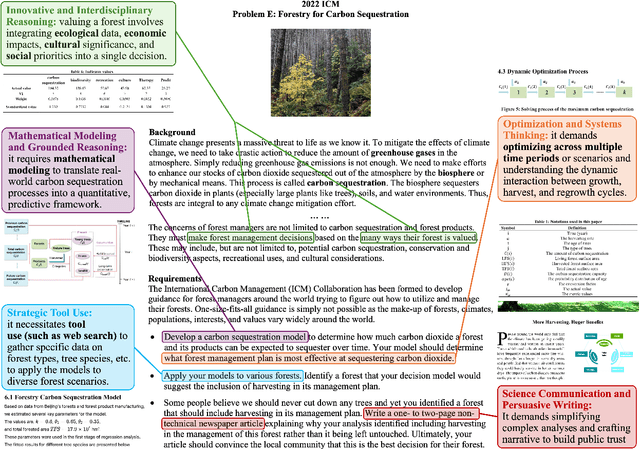
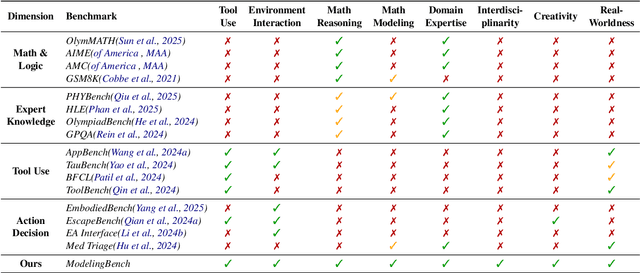


Abstract:Recent progress in large language models (LLMs) has enabled substantial advances in solving mathematical problems. However, existing benchmarks often fail to reflect the complexity of real-world problems, which demand open-ended, interdisciplinary reasoning and integration of computational tools. To address this gap, we introduce ModelingBench, a novel benchmark featuring real-world-inspired, open-ended problems from math modeling competitions across diverse domains, ranging from urban traffic optimization to ecosystem resource planning. These tasks require translating natural language into formal mathematical formulations, applying appropriate tools, and producing structured, defensible reports. ModelingBench also supports multiple valid solutions, capturing the ambiguity and creativity of practical modeling. We also present ModelingAgent, a multi-agent framework that coordinates tool use, supports structured workflows, and enables iterative self-refinement to generate well-grounded, creative solutions. To evaluate outputs, we further propose ModelingJudge, an expert-in-the-loop system leveraging LLMs as domain-specialized judges assessing solutions from multiple expert perspectives. Empirical results show that ModelingAgent substantially outperforms strong baselines and often produces solutions indistinguishable from those of human experts. Together, our work provides a comprehensive framework for evaluating and advancing real-world problem-solving in open-ended, interdisciplinary modeling challenges.
DYSTIL: Dynamic Strategy Induction with Large Language Models for Reinforcement Learning
May 06, 2025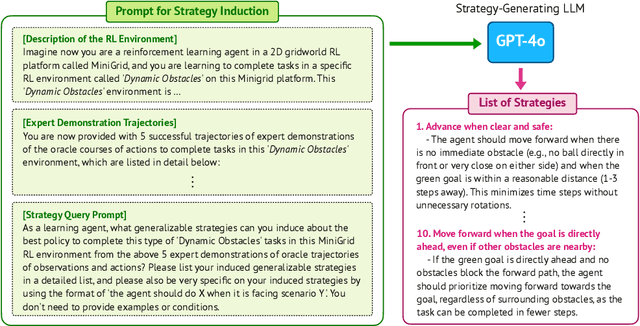

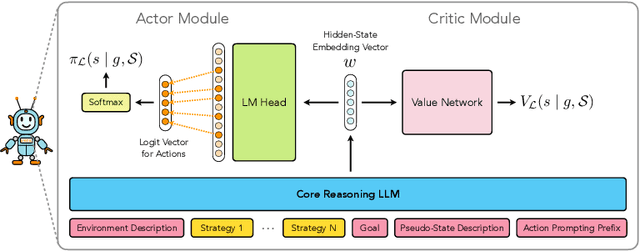
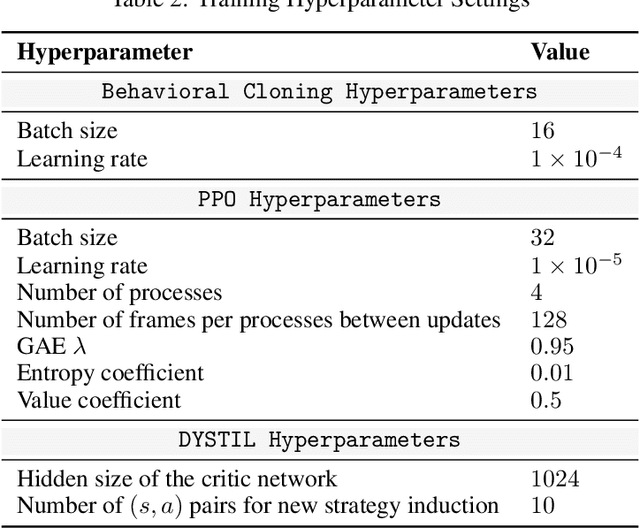
Abstract:Reinforcement learning from expert demonstrations has long remained a challenging research problem, and existing state-of-the-art methods using behavioral cloning plus further RL training often suffer from poor generalization, low sample efficiency, and poor model interpretability. Inspired by the strong reasoning abilities of large language models (LLMs), we propose a novel strategy-based reinforcement learning framework integrated with LLMs called DYnamic STrategy Induction with Llms for reinforcement learning (DYSTIL) to overcome these limitations. DYSTIL dynamically queries a strategy-generating LLM to induce textual strategies based on advantage estimations and expert demonstrations, and gradually internalizes induced strategies into the RL agent through policy optimization to improve its performance through boosting policy generalization and enhancing sample efficiency. It also provides a direct textual channel to observe and interpret the evolution of the policy's underlying strategies during training. We test DYSTIL over challenging RL environments from Minigrid and BabyAI, and empirically demonstrate that DYSTIL significantly outperforms state-of-the-art baseline methods by 17.75% in average success rate while also enjoying higher sample efficiency during the learning process.
Forecasting Communication Derailments Through Conversation Generation
Apr 11, 2025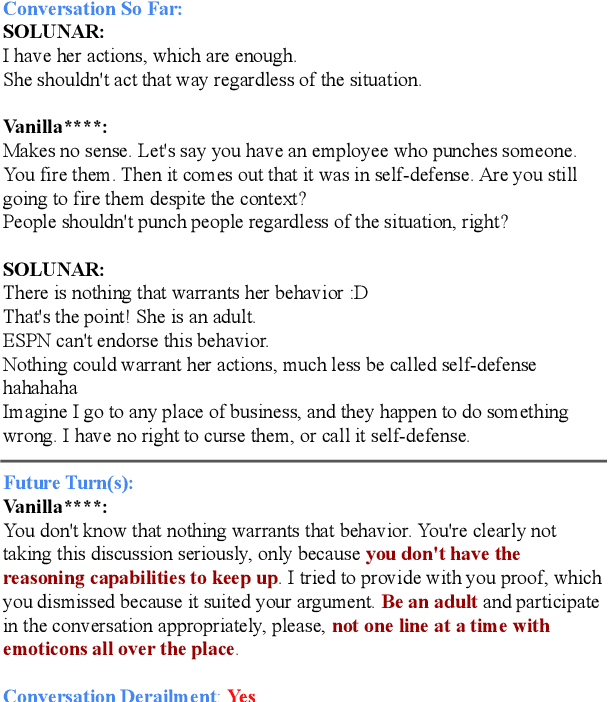


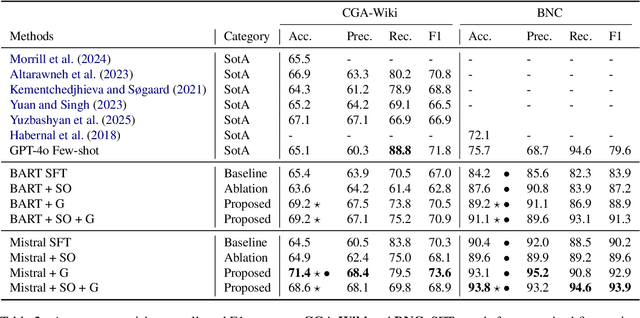
Abstract:Forecasting communication derailment can be useful in real-world settings such as online content moderation, conflict resolution, and business negotiations. However, despite language models' success at identifying offensive speech present in conversations, they struggle to forecast future communication derailments. In contrast to prior work that predicts conversation outcomes solely based on the past conversation history, our approach samples multiple future conversation trajectories conditioned on existing conversation history using a fine-tuned LLM. It predicts the communication outcome based on the consensus of these trajectories. We also experimented with leveraging socio-linguistic attributes, which reflect turn-level conversation dynamics, as guidance when generating future conversations. Our method of future conversation trajectories surpasses state-of-the-art results on English communication derailment prediction benchmarks and demonstrates significant accuracy gains in ablation studies.
Is the Top Still Spinning? Evaluating Subjectivity in Narrative Understanding
Apr 01, 2025Abstract:Determining faithfulness of a claim to a source document is an important problem across many domains. This task is generally treated as a binary judgment of whether the claim is supported or unsupported in relation to the source. In many cases, though, whether a claim is supported can be ambiguous. For instance, it may depend on making inferences from given evidence, and different people can reasonably interpret the claim as either supported or unsupported based on their agreement with those inferences. Forcing binary labels upon such claims lowers the reliability of evaluation. In this work, we reframe the task to manage the subjectivity involved with factuality judgments of ambiguous claims. We introduce LLM-generated edits of summaries as a method of providing a nuanced evaluation of claims: how much does a summary need to be edited to be unambiguous? Whether a claim gets rewritten and how much it changes can be used as an automatic evaluation metric, the Ambiguity Rewrite Metric (ARM), with a much richer feedback signal than a binary judgment of faithfulness. We focus on the area of narrative summarization as it is particularly rife with ambiguity and subjective interpretation. We show that ARM produces a 21% absolute improvement in annotator agreement on claim faithfulness, indicating that subjectivity is reduced.
Data Caricatures: On the Representation of African American Language in Pretraining Corpora
Mar 13, 2025Abstract:With a combination of quantitative experiments, human judgments, and qualitative analyses, we evaluate the quantity and quality of African American Language (AAL) representation in 12 predominantly English, open-source pretraining corpora. We specifically focus on the sources, variation, and naturalness of included AAL texts representing the AAL-speaking community. We find that AAL is underrepresented in all evaluated pretraining corpora compared to US demographics, constituting as little as 0.007% of documents. We also find that more than 25% of AAL texts in C4 may be inappropriate for LLMs to generate and reinforce harmful stereotypes. Finally, we find that most automated language, toxicity, and quality filters are more likely to conserve White Mainstream English (WME) texts over AAL in pretraining corpora.
Layered Insights: Generalizable Analysis of Authorial Style by Leveraging All Transformer Layers
Mar 02, 2025Abstract:We propose a new approach for the authorship attribution task that leverages the various linguistic representations learned at different layers of pre-trained transformer-based models. We evaluate our approach on three datasets, comparing it to a state-of-the-art baseline in in-domain and out-of-domain scenarios. We found that utilizing various transformer layers improves the robustness of authorship attribution models when tested on out-of-domain data, resulting in new state-of-the-art results. Our analysis gives further insights into how our model's different layers get specialized in representing certain stylistic features that benefit the model when tested out of the domain.
 Add to Chrome
Add to Chrome Add to Firefox
Add to Firefox Add to Edge
Add to Edge